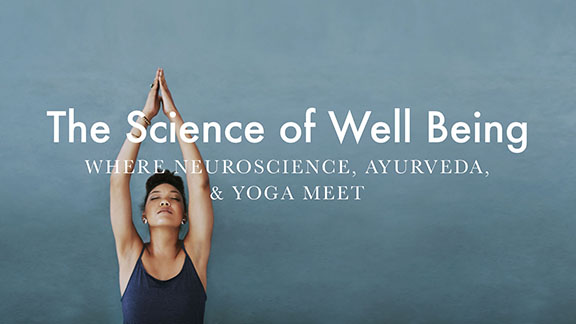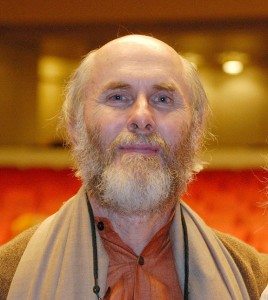 Ayurveda and Yoga are sister sciences. In this interview, David Frawley, PhD (Pandit Vamadeva Shastri) addresses their complementarity and where asana fits into both of these ancient systems from a holistic perspective. He also clarifies the intent of asana and the broader goal of Yoga from a classical view, drawing from the Yoga Sutras and Hatha Yoga Pradipika.
Ayurveda and Yoga are sister sciences. In this interview, David Frawley, PhD (Pandit Vamadeva Shastri) addresses their complementarity and where asana fits into both of these ancient systems from a holistic perspective. He also clarifies the intent of asana and the broader goal of Yoga from a classical view, drawing from the Yoga Sutras and Hatha Yoga Pradipika.
Integral Yoga Magazine (IYM): How does Ayurveda incorporate asana?
David Frawley (DF): Ayurveda usually prescribes asana either for a healthy lifestyle or as part of certain therapies. A healthy lifestyle should include exercise and asana, ideally because of the spiritual dimension of asana. The main health problem in life comes from gravity and aging. If you do inverted poses you are improving your longevity so it’s relevant to everyone. Then there are asanas that are part of the doshic model. Ayurveda takes into account the dosha and the structural condition of people. Ayurveda says the whole purpose of Yoga practice as far as health goes is to eliminate excesses in the doshas, which means to develop stillness and relaxation. To be a healthy person you don’t have to be capable of a perfect pose.
IYM: What is the distinction between asana and exercise in Ayurveda?
DF: Exercise has its place and asana has another. In Ayurveda, we have a separate word for exercise: vyayama. Asana means “the seat” in Sanskrit and implies a sitting pose, unless it’s further defined. That means that you had to be in that pose for some time to apply the term “asana.” It was only much later that people added sequences and movements to asana practice.
Yoga in general and asana as a part of Yoga, implies a movement from rajas (activity) to sattva (stillness, balance). Essentially what people call a workout is a movement from tamas (inertia) to rajas, but it is not Yoga if we define it in the classical sense. To qualify as Yoga, it would require an additional level of calming, balancing, stillness and introversion. If sattva guna isn’t brought in, then its vyayama. The simplest way to understand this is in relation to the three gunas (qualities of nature). As a general principle, the body has a tendency toward tamas, the prana toward rajas and the mind toward sattva. The body tends to develop inertia, waste materials, sleep, and so on. The body is part of the earth and has a heavy quality. In the Ayurvedic system, exercise—which we all need to some degree—is utilized to remove tamas at a physical level.
IYM: Are you concerned about how asana is practiced today?
DF: The new formula is asana plus kirtan. I always joke that the LA definition of Yoga is asana plus shopping! [Laughs] Asana is becoming like a youth movement: Yoga on the beach with music and a barbeque. If you go to Thailand you see this. But as we age, exercise must become more gentle, easeful and restorative and that’s the more classical approach to the asana. Asanas should exercise the body sufficiently, but need not train the body athletically. There’s nothing wrong in becoming a gymnast or excelling at difficult asanas, but it gives the wrong idea as to what asana is all about. You don’t want people to feel bad if they can’t do athletic asanas or bend into pretzel shapes, particularly if they want to do Yoga for healing.
The fact is that Yoga in the USA is business driven, like any other business, by the demands of the market. I’m not criticizing this; it’s just what it has become. The demands of a business are very different than a focus on a spiritual practice. Because we live in a media age, we tend to identify those with the largest classes and those teaching the most celebrities as being the Yoga stars and best teachers. But, we don’t say the best physicist is the one with the most celebrities or the biggest classes. So we need to recognize the difference between the one doing cutting edge research and the media-popularized one.
We have a generation of people who are happy with a non-spiritual Yoga. There are people who do asanas for the lower back and call it a muladhara chakra workout! You can’t workout a chakra as if you could get into the chakra by moving the muscles! Asana does have a lot of benefits and people in western culture are very physically oriented, so it’s appealing. And because of our culture, we’ve created a more movement oriented or viniyasa approach. We may need this because we don’t move very much, but even the movement oriented approaches should move us into stillness.
IYM: As a sadhana or spiritual practice?
DF: If you want to teach Yoga in its classical and broadest sense, then that means sadhana and asanas would have to be linked to pranayama, mantra and meditation. That’s why the Yoga Sutras has the section titled, “Sadhana Pada.” Ultimately, the purpose of asana is to awaken the prana and get it to move inwardly, not just to make the body achieve a desirable position. What is the state of mind of the person doing the asana? Is a pose done with relaxation of the prana rather than the effort of the ego? That is important. Classical Yoga’s focus is to let go of body consciousness, not to emphasize it.
Stillness is where the healing energy can come forth and spiritual energy requires stillness, silence and calm. Essentially, this is the state of balance. The classical approach to asana is that you move from exercise to a sitting pose, or a pose that is held and then the rest of Yoga proceeds. In that respect, Ayurveda recognizes that asana has another value beyond exercise because it can calm the vata dosha, improve the agni (fire), counter the aging process, and also help calm the mind and emotions. When the body is in the state of stillness the prana can move, can come forth. That inner prana has the capacity to renew the body and the mind. Normally we disperse the prana outwardly through the activities of our motor organs. If we create stillness, the body can become a vessel for holding the inner prana.
IYM: What about asanas in Yoga therapy?
DF: Therapy is applying the asanas more specifically to treat diseases. Disease is also an obstacle for the sadhana. You don’t want your house to be burning down or you can’t do sadhana. Specific asanas have their own therapeutic effects. There are asanas that can help with headaches or asthma, but the asana is not a full or direct treatment. Today people think there is an asana for everything. Asana is not, in itself, a complete therapy. To use it therapeutically, it’s primarily for musculo-skeletal therapy and support for everything else, and needs to be combined with a broader treatment plan, including diet. Of course, Ayurveda would be the ideal as it’s the natural healing system inherent in the Yoga tradition.
IYM: What role does diet, pranayama and meditation play?
DF: Some people feel that asana is all that is needed and it is even their meditation. But we don’t find that statement in any classical literature. From a Yoga standpoint, asana is a foundation for other Yoga practices and not an end in itself. You can have a disturbed mind in a relatively still body. You can see flexibility—like in Cirque du Soleil—they have to have some focus but they don’t necessarily do meditation. A main goal of Yoga is flexibility of the mind and asana is usually not going to be enough to achieve that. Most of the classical Yoga texts place more emphasis on pranayama than asana, because pranayama is connected to the kundalini.
The health of the body rests upon nutrition. The Hatha Yoga Pradipika has a long section on yogic diet. To get the best benefit from asana, you need a yogic diet. The Pradipika has four sections. The main section introduces the background and qualifications for practicing Yoga and introduces the asanas as the first stage of Yoga. Then it explains not only asana, but diet. The second section deals mainly with pranayama and the shatkarmas, which are practices used for purification. It explains some of the bandhas (yogic locks) and spiritual practices that develop from pranayama practice. The third section explains special practices of mudras and bandhas and the fourth goes more specifically into meditation and samadhi. So, there is a sequence of practice given by the Pradipika.
IYM: How do we change the language of modern day Yoga?
DF: If you talk about Yoga, most people think it’s asana. And if it’s asana they think you do all these contortions and it’s gymnastics. Yoga means integration. Yoga teachers who study the Yoga Sutras can change their language. An advanced yogi is not one who can do difficult postures, but one who can access the higher samadhis. Patanjali defines asana as relaxation into infinity. If you really study the Yoga Sutras and commentaries you can go deeper. For example, concentration (dharana), whether in an asana or in meditation, isn’t just about focusing on something. Patanjali implies it’s fixing the mind with viveka (discrimination) and vairagya (dispassion).
I always correct people who say they are “going to Yoga class” but mean an asana class. We need to continue to explain the deeper meanings. The goal of Yoga is not asana. You get a sufficient vehicle to take you where you are going, but when the car becomes an end in itself, you may not reach your goal. We need to bring back the terms inner Yoga and outer Yoga. Inner Yoga refers to meditation. Outer Yoga is asana and pranayama. The inner changes how we feel. You can change how you look, but what really matters is changing how you feel.
About David Frawley:
 David Frawley is one of the world’s most respected Vedic astrologers and Ayurvedic doctors. He is on the advisory board for the National Ayurvedic Medical Association (NAMA) and is a regular keynote speaker at NAMA conferences. His work is prominent in the Ayurvedic field throughout the world. He is Founder and Director of the American Institute of Vedic Studies and the author of thirty books. His latest book, Mantra Yoga and Primal Sound is now available. For more information, please visit: www.vedanet.com.
David Frawley is one of the world’s most respected Vedic astrologers and Ayurvedic doctors. He is on the advisory board for the National Ayurvedic Medical Association (NAMA) and is a regular keynote speaker at NAMA conferences. His work is prominent in the Ayurvedic field throughout the world. He is Founder and Director of the American Institute of Vedic Studies and the author of thirty books. His latest book, Mantra Yoga and Primal Sound is now available. For more information, please visit: www.vedanet.com.

